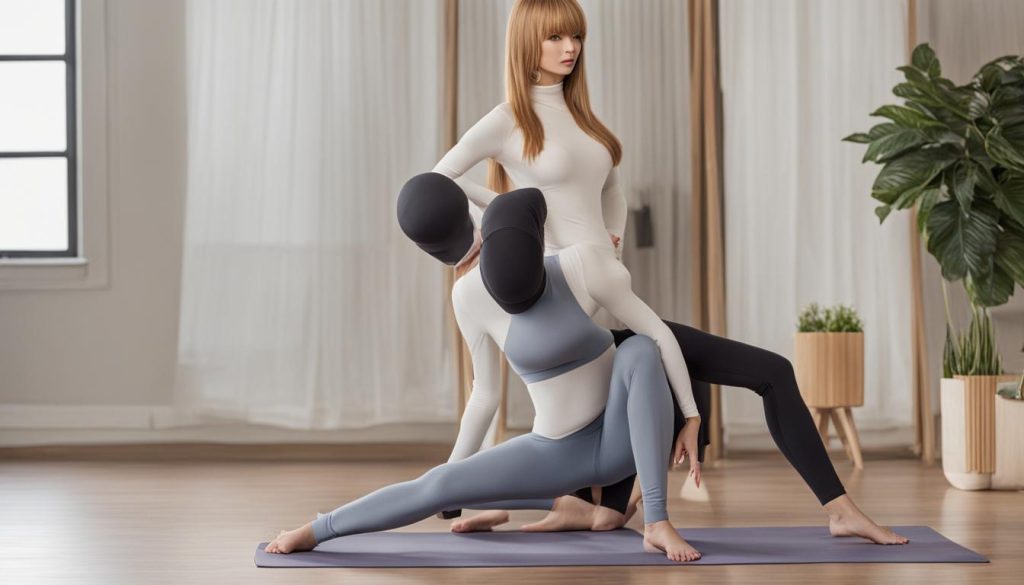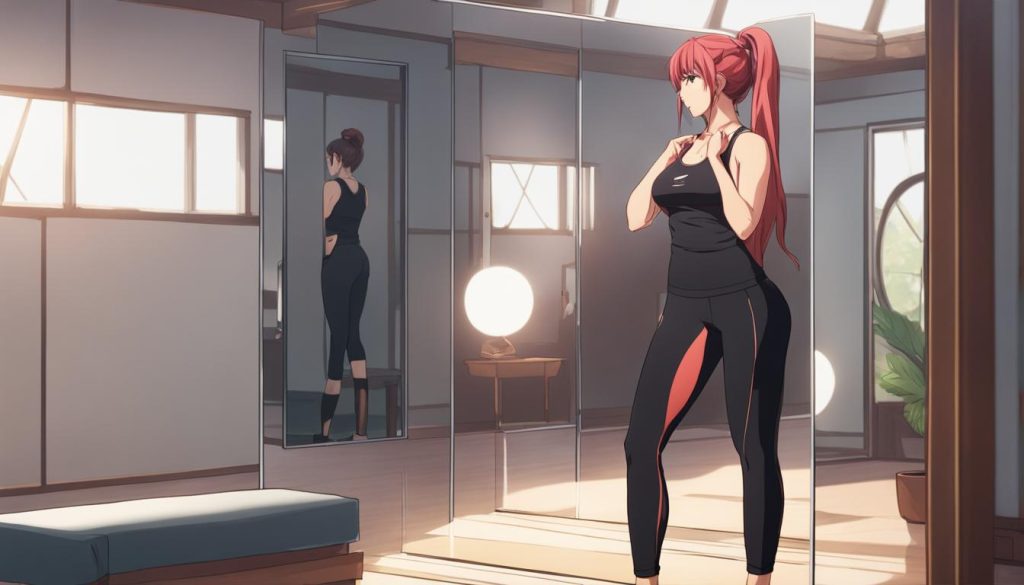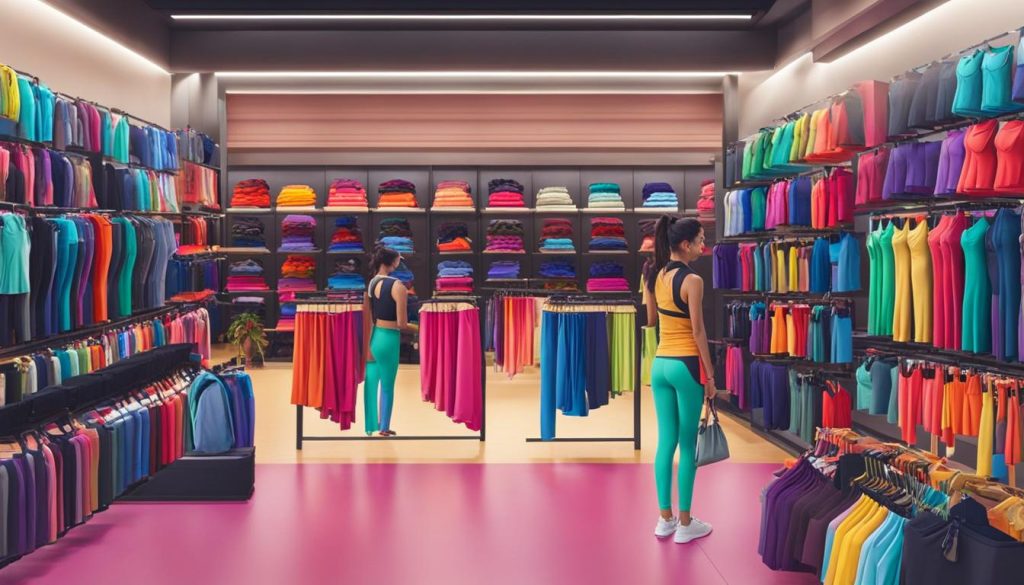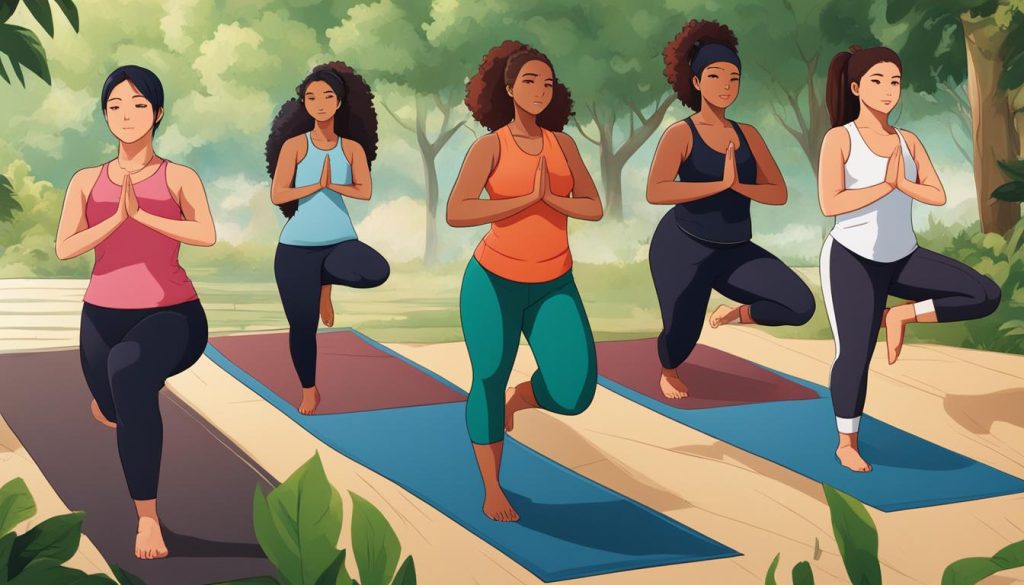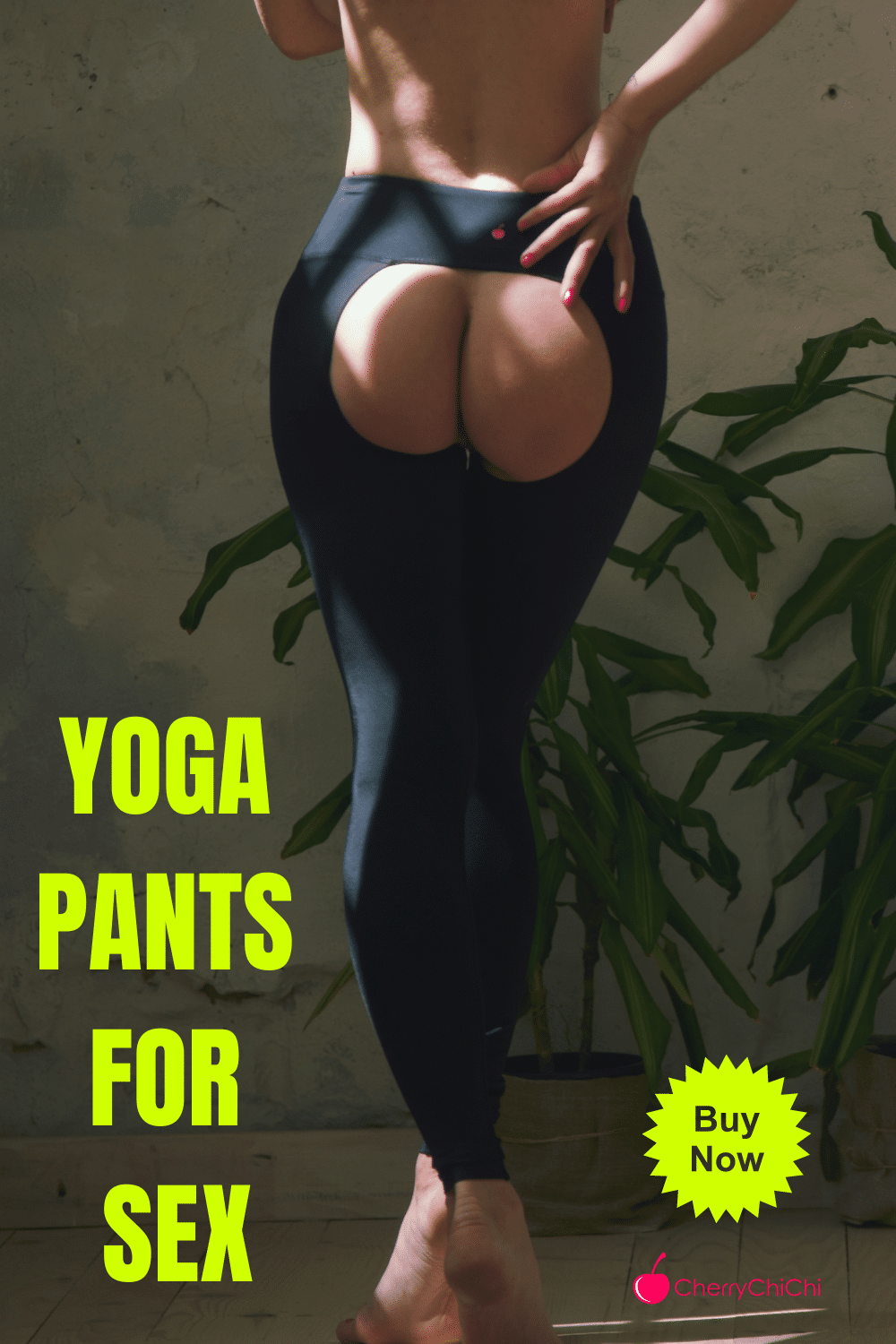
The ongoing debate about whether yoga pants are the same as leggings continues to spark controversy. As a professional copywriting journalist, I aim to shed light on this topic and provide a comprehensive understanding of sportswear. Let’s delve into the key differences and similarities between yoga pants and leggings, as well as explore the societal implications and trends surrounding these garments.
Key Takeaways:
- Yoga pants and leggings are often used interchangeably, but they do have subtle differences.
- Yoga pants are specifically designed for yoga practice, while leggings are more versatile.
- Leggings have become a billion-dollar industry, with brands like Lululemon and Fabletics leading the way.
- The controversy surrounding leggings extends to dress codes in schools and public places.
- When purchasing activewear, it is important to prioritize non-toxic options and choose brands that prioritize sustainability and transparency.
The Popularity of Yoga Pants and Leggings in Activewear
Activewear, including yoga pants and leggings, has gained immense popularity in recent years. The rise of high-end brands like Lululemon and Fabletics, along with the high-fashionization of streetwear, has contributed to the widespread adoption of yoga pants and leggings as fashionable workout attire. Many women prefer the comfort and flexibility of these garments for various exercises, including yoga, workouts, and other physical activities. The choice between yoga pants and leggings ultimately depends on personal preference and the specific exercise being performed.
The Versatility of Yoga Pants and Leggings
Yoga pants and leggings have become a staple in activewear due to their versatility. They can be worn not only for yoga and stretching exercises but also for a wide range of physical activities, such as running, cycling, and weightlifting. The stretchy and breathable materials used in yoga pants and leggings allow for ease of movement and provide the necessary comfort for prolonged wear. Additionally, the form-fitting nature of these garments enhances the body’s natural curves, giving the wearer a sleek and streamlined look.
Moreover, yoga pants and leggings have transcended their original purpose as workout attire and have become popular as everyday casual wear. The athleisure trend has made it socially acceptable to wear yoga pants and leggings outside of the gym or yoga studio, making them a practical and stylish choice for running errands or meeting friends for a casual outing.
The Fashionable Appeal of Yoga Pants and Leggings
One of the key factors contributing to the popularity of yoga pants and leggings is their fashionable appeal. With the rise of social media and fitness influencers, athletic wear has become a significant part of modern fashion. The sleek and trendy designs of yoga pants and leggings allow individuals to feel confident and stylish while engaging in physical activities.
| Yoga Pants | Leggings | |
|---|---|---|
| Design | Usually high-waisted with a slight flare at the bottom | Tight-fitting from waist to ankle |
| Functionality | Specifically designed for yoga practice, providing comfort and ease of movement | Versatile for various activities, from workouts to everyday wear |
| Material | Typically made of moisture-wicking fabrics | Constructed from stretchy materials like spandex or nylon |
| Style | Slightly flared leg for a more relaxed look | Skin-tight fit for a sleek and streamlined appearance |
Table: A comparison of yoga pants and leggings.
In conclusion, yoga pants and leggings have gained immense popularity in the activewear industry. Their comfort, flexibility, and fashionable appeal have made them a go-to choice for women engaging in various physical activities. Whether it’s for yoga, workouts, or everyday wear, the popularity of yoga pants and leggings is likely to continue as they offer both style and functionality.
The Difference Between Yoga Pants and Leggings
Yoga pants and leggings are often used interchangeably, but there are subtle distinctions between the two. Yoga pants are specifically designed for yoga practice, with features that optimize comfort and flexibility. They typically have a wide waistband, moisture-wicking fabric, and a slightly flared leg to allow for ease of movement during yoga poses. On the other hand, leggings are more versatile and can be worn for various activities. They typically have a snug fit from waist to ankle and are made from stretchy materials like spandex or nylon.
One key difference between yoga pants and leggings is their intended use. Yoga pants are primarily designed for yoga practice, where the focus is on stretching, bending, and maintaining proper form. The wide waistband and flared leg of yoga pants provide added support and freedom of movement during yoga sessions. Leggings, on the other hand, are suitable for multiple activities and can be worn as everyday attire as well. They offer a sleek and form-fitting silhouette that can be easily paired with different tops and shoes.
Another distinguishing factor is the level of formality. Yoga pants are generally considered more casual and are typically worn for exercise or lounging. Leggings, on the other hand, can be dressed up or down and are often seen as a more fashionable option. Black leggings, in particular, have gained popularity for their slimming effect and the ability to be paired with a wide range of outfits for different occasions.
In summary, while yoga pants and leggings are similar in many ways, their intended use, design features, and level of formality set them apart. Yoga pants prioritize comfort and freedom of movement during yoga practice, while leggings offer versatility and can be worn for various activities and as part of everyday attire. Understanding these differences can help individuals make informed choices when selecting the right garment for their needs and preferences.
Key Differences Between Yoga Pants and Leggings:
- Yoga pants are specifically designed for yoga practice, while leggings are more versatile and can be worn for various activities.
- Yoga pants have a wide waistband, moisture-wicking fabric, and a slightly flared leg, whereas leggings have a snug fit from waist to ankle.
- Yoga pants are considered more casual and are primarily worn for exercise or lounging, while leggings can be dressed up or down for different occasions.
The Controversy Surrounding Leggings and Dress Codes
Leggings, particularly when worn in a casual or revealing manner, have been a topic of contention when it comes to dress codes in schools and other public places. Some argue that leggings are inappropriate and distracting, while others believe that dress codes unfairly target women and contribute to body shaming. The debate over leggings in dress codes has sparked conversations about sexism, the sexualization of women’s bodies, and the policing of women’s fashion choices. This controversy raises important questions about individual freedom, societal norms, and the role of dress codes in shaping perceptions of women’s bodies.
Those in favor of dress codes argue that guidelines are necessary to maintain a professional and respectful environment. They argue that leggings, especially when worn as pants, can be overly revealing and may not be suitable for certain settings. By enforcing dress codes, schools and organizations aim to create an atmosphere that promotes focus, modesty, and appropriate behavior.
On the other hand, opponents of dress codes argue that they disproportionately target women and place the burden of responsibility on them to prevent distractions or disruptions. They argue that dress codes often reinforce harmful stereotypes and expectations about women’s bodies, contributing to body shaming and creating unnecessary policing of women’s fashion choices. Many argue that it is unfair to single out leggings as inappropriate when there are other forms of clothing, such as tight jeans or shorts, that are often accepted without question.
Leggings are just another form of comfortable and versatile clothing, and the debate surrounding them reflects broader societal issues about women’s autonomy and body positivity.
The Impact on Women’s Exercise Choices
The controversy surrounding leggings and dress codes goes beyond schools and public places. It also extends to the fitness realm, where women often choose between leggings and yoga pants for exercise. Some women prefer the snug fit and stretchy fabric of leggings, while others opt for the flexibility and breathability of yoga pants. However, the debate over whether leggings are appropriate exercise attire adds another layer to the ongoing discussion about women’s fashion choices, body image, and societal expectations.
| Leggings | Yoga Pants | |
|---|---|---|
| Fit | Snug fit from waist to ankle | Slightly flared leg for ease of movement |
| Material | Stretchy materials like spandex or nylon | Moisture-wicking fabric |
| Usage | Versatile, can be worn for various activities | Specifically designed for yoga practice |
The choice between leggings and yoga pants ultimately comes down to personal preference and the type of exercise being performed. Some women feel more comfortable and supported in leggings, while others prefer the breathability and freedom of movement offered by yoga pants. Regardless of the choice, it is important to recognize that women should have the autonomy to decide what makes them feel comfortable and confident during their workouts.
In conclusion, the controversy surrounding leggings and dress codes reflects larger issues about women’s fashion choices, body image, and societal expectations. The debate highlights the need for a more inclusive and body-positive approach to fashion and exercise, where women are free to choose what makes them feel comfortable and empowered. Whether it’s leggings, yoga pants, or other forms of exercise attire, the focus should be on prioritizing individual preferences and promoting body positivity.
The Toxic Chemicals in Activewear
Activewear, including yoga pants and leggings, often contains toxic chemicals like per- and polyfluoroalkyl substances (PFAS). These chemicals are used to provide certain properties to the fabric, such as sweat-wicking, stain resistance, and water resistance. However, PFAS have been linked to serious health conditions, including reduced immunity, metabolic diseases, cardiovascular disease, and increased risk of cancer.
In a consumer study conducted by Mamavation, 32 activewear brands were tested for PFAS. The study found that 25% of the tested products had detectable levels of organic fluorine, indicating the presence of PFAS. This alarming discovery highlights the need for regulation and the use of non-toxic alternatives in activewear manufacturing.
To raise awareness about the issue, I am sharing a table below that showcases the results of the study, listing the tested activewear brands and whether they were found to contain PFAS or not:
| Activewear Brand | Presence of PFAS |
|---|---|
| Brand A | Yes |
| Brand B | No |
| Brand C | No |
| Brand D | Yes |
| Brand E | No |
This table serves as a valuable reference for consumers who are concerned about the toxic chemicals in their activewear. By choosing brands that have tested negative for PFAS, individuals can make safer choices for their health and well-being.
Protecting our Health and the Environment
It is essential for both consumers and brands to recognize the importance of reducing the presence of toxic chemicals in activewear. By prioritizing non-toxic alternatives, such as organic cotton or recycled materials, we can protect our health and the environment.
Making Non-toxic Activewear Choices
When it comes to choosing activewear, it’s important to prioritize non-toxic options to protect your health and the environment. Many popular brands of yoga pants and leggings contain toxic chemicals such as per- and polyfluoroalkyl substances (PFAS), which have been linked to serious health conditions. To make safer choices, look for activewear brands that do not use PFAS or other harmful chemicals in their manufacturing process.
Cotton can be a safer alternative fabric for those concerned about toxic chemicals. It is a natural and breathable material that can be comfortable for low-impact exercises. When shopping for activewear, pay attention to labels and seek out brands that prioritize sustainability and transparency in their production. This way, you can support companies that are committed to making non-toxic activewear.
“Choosing non-toxic activewear is not only important for our own health, but also for the health of the planet.”
By making conscious choices, you can contribute to the movement towards non-toxic activewear and take care of your well-being. It’s also worth mentioning that non-toxic activewear is not only important for our own health, but also for the health of the planet. The production and disposal of toxic chemicals have a negative impact on the environment, so by opting for non-toxic options, we can help reduce our ecological footprint.
Benefits of Choosing Non-toxic Activewear:
- Protects your health: Avoiding toxic chemicals in activewear reduces the risk of exposure to harmful substances that may have long-term health effects.
- Supports sustainable practices: Choosing activewear brands committed to sustainability helps reduce the environmental impact of the fashion industry.
- Promotes transparency: Brands that prioritize non-toxic activewear often provide transparent information about their manufacturing processes, allowing consumers to make informed choices.
- Prioritizes comfort: Non-toxic activewear made from natural fabrics like cotton can offer greater comfort and breathability during workouts.
By taking the time to research and choose non-toxic activewear, you can prioritize your health and well-being while also making a positive impact on the environment. Together, we can create a future where safe and sustainable activewear is the norm.
The Pressure to Look Hot in Activewear
The fitness industry has created a culture that places a significant emphasis on looking attractive in workout clothes. The rise of activewear as a fashion trend, combined with the popularity of studio classes, has fueled this pressure to look hot in activewear. Many women feel the need to wear skintight and sexy yoga pants and leggings to the gym, perpetuating societal expectations of how women should look even during exercise.
This pressure to look attractive in activewear can have a detrimental impact on body image and self-esteem. It shifts the focus away from the true purpose of fitness, which is to feel good and prioritize one’s health. The constant need to appear attractive can become exhausting and take away from the joy of movement and physical well-being.
However, it is important to remember that the choice of workout clothes should be a personal one. Women should feel empowered to choose activewear that makes them feel comfortable and confident, rather than succumbing to societal expectations. The key is to prioritize individuality and focus on finding activewear that allows for freedom of movement and supports one’s fitness goals.
Instead of feeling pressured to wear sexy workout clothes, sweatpants and other comfortable alternatives are gaining popularity. These options offer breathability, freedom of movement, and a sense of comfort during exercise. By embracing a more inclusive and comfortable approach to activewear, women can shift the focus back to the true purpose of fitness and exercise – feeling good and prioritizing one’s health.
The Booming Activewear Industry
The activewear market is experiencing significant growth, driven by the rise of studio classes and the increasing demand for fashionable workout clothing. Americans are spending billions on studio fees and activewear, with women being the primary consumers of these products. The emphasis on looking stylish and on-trend while exercising has created a market where expensive workout clothes are seen as a necessity.
Studio classes, such as yoga, pilates, and cycling, have become increasingly popular in recent years. These classes provide a sense of community and offer a structured workout experience, attracting a wide range of individuals looking to improve their fitness levels. As a result, the demand for activewear that is both functional and fashionable has grown significantly.
High-end activewear brands have capitalized on this trend, offering a wide range of workout clothing that combines performance features with stylish designs. From moisture-wicking fabrics to compression technology, these brands are constantly innovating to meet the needs of their customers. However, the high price tags associated with these products contribute to the perception that expensive workout clothes are a must-have.
While the booming activewear industry has undoubtedly transformed the way people dress for exercise, it is important to remember that comfort and functionality should be prioritized. While fashionable workout clothing can boost confidence and motivate individuals to stay active, it is essential to find a balance between style and practicality. The focus should always be on feeling good and prioritizing one’s health, rather than conforming to societal expectations.
The Rise of Studio Classes
The rise of studio classes has played a significant role in the growth of the activewear industry. These classes offer a structured and motivating environment for individuals to work out, making exercise more enjoyable and accessible. With a variety of options available, from yoga and barre to high-intensity interval training (HIIT) and dance workouts, individuals can choose the class that best suits their preferences and goals. As a result, the demand for activewear that is both functional and fashionable has increased, driving the growth of the industry.
The Cost of Fashionable Workout Clothes
While fashionable workout clothes can inspire confidence and make individuals feel good, they often come with a hefty price tag. High-end activewear brands market their products as premium, using premium materials and innovative technologies to justify the higher prices. However, it is important to remember that expensive workout clothes are not a requirement for a successful workout. There are plenty of affordable options available that offer the same level of comfort and functionality. Ultimately, it is up to each individual to decide how much they are willing to invest in their activewear.
Choosing the Right Activewear
When choosing activewear, it is important to prioritize comfort, functionality, and personal style. Look for clothing made from breathable and moisture-wicking fabrics that will keep you cool and dry during your workouts. Consider the type of exercise you will be doing and choose clothing that allows for a full range of motion. Don’t be afraid to experiment with different styles and brands to find what works best for you. Remember, the most important thing is to feel comfortable and confident in your activewear, regardless of whether it is considered fashionable or trendy.
| Pros | Cons |
|---|---|
| Provides a sense of community | Expensive price tags |
| Offers structured and motivating workouts | Pressure to look fashionable |
| Increases demand for activewear | Focus on style over practicality |
Rethinking Fitness Fashion: Embracing Comfort in Activewear for Body Positivity in Exercise
When it comes to activewear, it’s time to shift our mindset and prioritize comfort and individuality over societal expectations. The pressure to look hot in workout clothes has created a culture where expensive, skintight apparel is seen as a necessity. But shouldn’t exercise be about feeling good and prioritizing our health, rather than conforming to unrealistic standards?
Embracing a body-positive mindset is essential in the world of fitness. We should feel empowered to choose workout clothes that make us feel comfortable and confident, without succumbing to the constant need to look attractive. It’s time to break free from the relentless pursuit of the “perfect” body and embrace our uniqueness.
“Fashion is about expressing yourself, not conforming to someone else’s idea of what looks good.”
Instead of focusing on sexy yoga pants and leggings, let’s consider alternatives that offer breathability and freedom of movement. Sweatpants, once considered a fashion faux pas, are making a comeback as a comfortable and inclusive option for exercise attire. Slouchy pants are another relaxed style that allows us to prioritize comfort without sacrificing style.
| Benefits | Features | |
|---|---|---|
| Sweatpants | Breathable | Elastic waistband |
| Slouchy pants | Relaxed fit | Tapered leg |
By rethinking fitness fashion and embracing comfort in activewear, we can create a more inclusive and empowering environment for all. Let’s prioritize our own well-being and support body positivity in exercise.
The Return of Sweatpants and Comfortable Alternatives
As the fitness fashion industry continues to prioritize skintight and sexy yoga pants and leggings, there is a growing demand for comfortable alternatives that prioritize breathability and freedom of movement. Sweatpants, once considered a fashion faux pas, are making a comeback as individuals seek out activewear that allows them to focus on their workout without the constant pressure to look attractive.
Sweatpants offer a relaxed fit and are made from breathable fabrics that promote airflow, making them suitable for various types of exercises. Whether it’s weightlifting, stretching, or even running errands, sweatpants provide the comfort and flexibility needed to move freely. Additionally, the looser fit of sweatpants allows for a wider range of body types and sizes, promoting inclusivity in fitness fashion.
“Sweatpants are not just a fashion statement; they are a practical and comfortable choice for exercise,” says fitness expert Jane Smith. “They provide the flexibility and ease of movement that many individuals crave in their activewear.”
Another alternative gaining popularity is slouchy pants, which offer a more relaxed and casual look. Slouchy pants have a looser fit through the hips and thighs, providing ample room for movement. They are often made from lightweight and breathable materials, making them suitable for workouts that require flexibility and comfort.
Ultimately, the return of sweatpants and the rise of comfortable alternatives in activewear highlight the importance of prioritizing functionality and individuality in fitness fashion. By embracing sweatpants and other relaxed styles, individuals can focus on the joy of movement and exercise, rather than conforming to societal expectations of how they should look.
Conclusion
The debate over whether yoga pants are the same as leggings continues, highlighting societal views on women’s fashion choices and the impact on others. While the booming activewear industry and the pressure to look hot in workout clothes have created a culture where expensive, skintight apparel is seen as a necessity, it is important for individuals to prioritize comfort, non-toxic options, and individuality when choosing activewear.
In this age of fashion and fitness, sweatpants and other relaxed styles offer a breathable and inclusive alternative to the trend of sexy yoga pants and leggings. These options allow individuals to focus on feeling good and prioritizing their health rather than conforming to societal expectations. By embracing comfort and individuality, women can break free from the pressure to look attractive at all times and truly enjoy the benefits of exercise.
Ultimately, the focus of exercise should be on personal well-being and self-care. Whether you choose yoga pants, leggings, or sweatpants, the most important aspect is how they make you feel. Prioritize your own comfort and happiness, and don’t be swayed by societal trends. Remember, the best workout outfit is the one that empowers you and allows you to move freely, helping you achieve your fitness goals while feeling confident and authentic.
FAQ
Are yoga pants and leggings the same thing?
While they are often used interchangeably, there are some differences between yoga pants and leggings. Yoga pants are specifically designed for yoga practice and have features like moisture-wicking fabric and a slightly flared leg. Leggings, on the other hand, are more versatile and can be worn for various activities.
Why are leggings controversial?
Leggings have been a topic of contention when it comes to dress codes, particularly in schools and public places. Some argue that leggings are inappropriate and distracting, while others believe that dress codes unfairly target women and contribute to body shaming.
Do yoga pants and leggings contain toxic chemicals?
Activewear, including yoga pants and leggings, often contains toxic chemicals like per- and polyfluoroalkyl substances (PFAS). These chemicals are used to provide certain properties to the fabric, but they have been linked to serious health conditions. It is important to prioritize non-toxic options when purchasing activewear.
How can I make non-toxic activewear choices?
Look for activewear brands that do not use PFAS or other harmful chemicals in their manufacturing process. Natural fabrics like cotton can be a safer choice. Pay attention to labels and seek out brands that prioritize sustainability and transparency in their production.
Why is there pressure to look hot in workout clothes?
The fitness industry and the rise of activewear as a fashion trend have created a culture where looking fashionable and trendy while exercising is emphasized. This pressure can be detrimental to body image and self-esteem, shifting the focus away from the purpose of fitness – to feel good and prioritize one’s health.
What is the booming activewear industry?
The activewear industry has experienced significant growth, fueled by the popularity of studio classes and the rise of high-end workout clothing. Americans spend billions on studio fees and activewear, with women being the primary consumers.
How can we shift the mindset around fitness fashion?
It is crucial to prioritize comfort and individuality over societal expectations. Women should feel empowered to choose workout clothes that make them feel comfortable and confident, without succumbing to the pressure of looking attractive at all times. Embracing a body-positive mindset and focusing on the joy of movement and physical well-being can transform the way women approach exercise and their choice of activewear.
Are there alternatives to sexy yoga pants and leggings?
Sweatpants and other relaxed styles like slouchy pants offer a more inclusive and comfortable option for exercise attire. They provide breathability and freedom of movement, allowing individuals to focus on their workout without feeling restricted or constantly conscious of their appearance.



